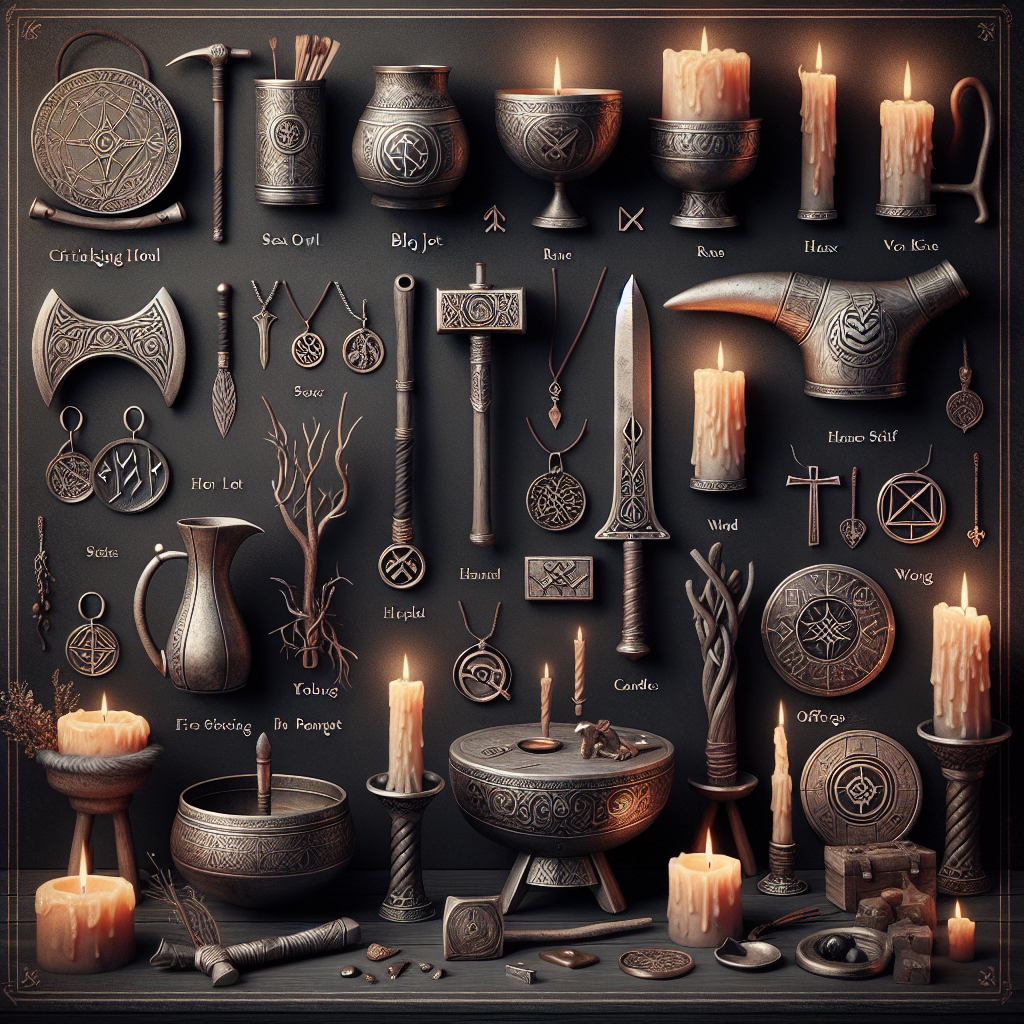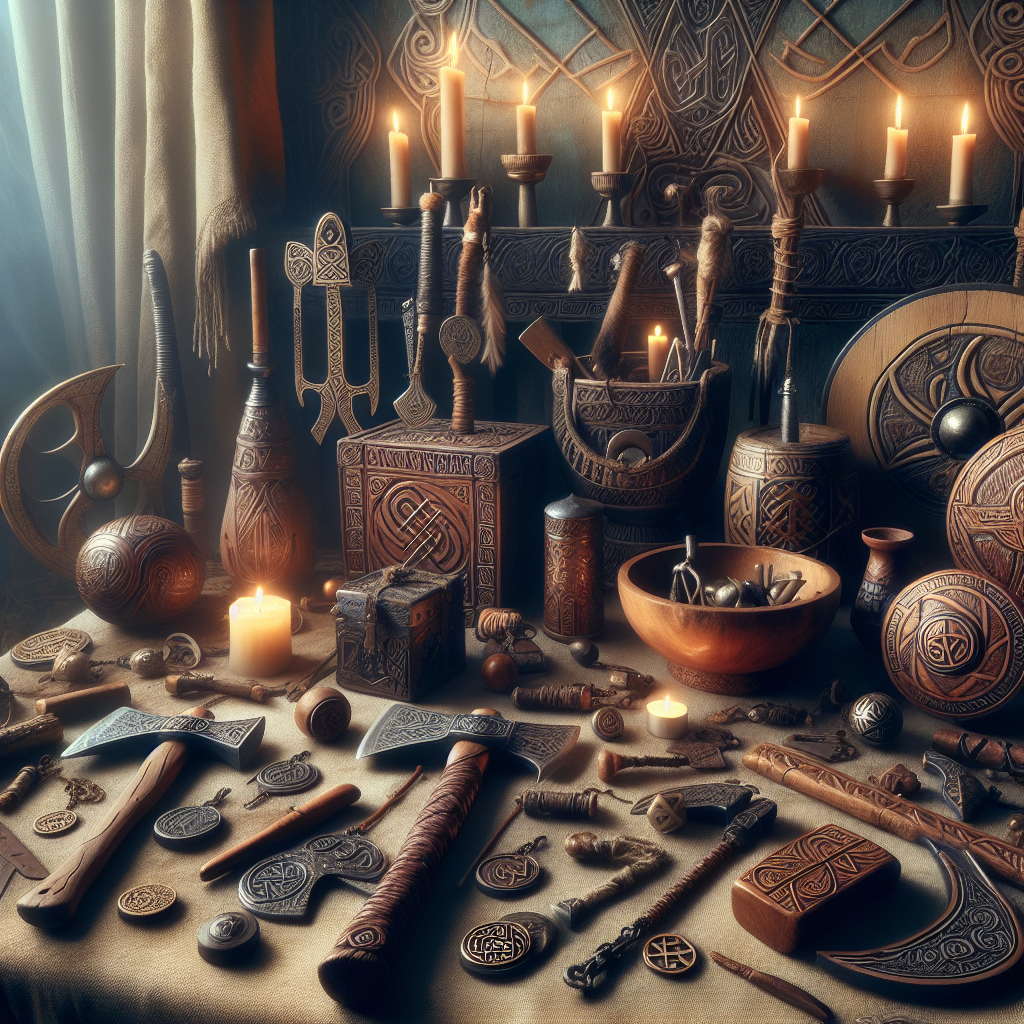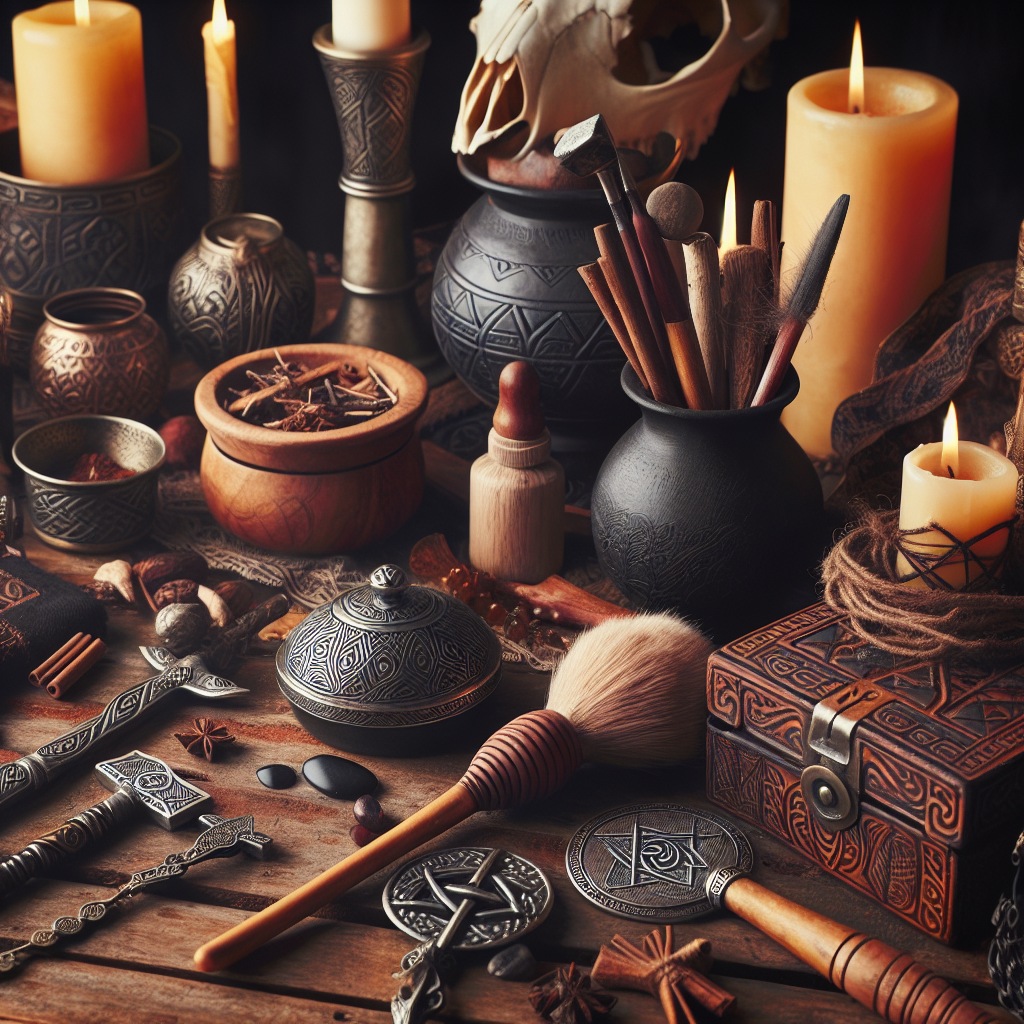As an Amazon Associate I earn from qualifying purchases.

In Norse Paganism, rituals are deeply connected to the natural and spiritual realms, drawing upon centuries-old traditions that are still practiced today. These rituals often involve intricate preparations and specific tools, each serving a unique purpose in the ceremonies.
u003cH2u003eHistorical Significance and Current Practiceu003c/H2u003e
The use of tools in Norse Pagan rituals can be traced back to ancient Scandinavia where the Vikings and other Germanic tribes conducted elaborate ceremonies to honor their gods, ancestors, and spirits. These practices have been revived in the modern era, with many people embracing Norse Paganism as a way to reconnect with their heritage and spirituality. Today, the rituals not only reflect ancient beliefs but also adapt to contemporary life, creating a unique blend of past and present.
u003cH3u003eThe Ritual Tools and Their Usesu003c/H3u003e
The essential tools for Norse Pagan rituals typically include items such as the Hammer (Mjölnir), which is used for sanctifying and protection; the Drinking Horn, often filled with mead or ale for toasts and oaths; and the Rune Set, which helps with divination and communication with the divine. Each tool embodies a particular aspect of the ritual, enriching the ceremony with symbolic meaning and spiritual significance.
Another indispensable tool is the Blot Bowl, used for offerings and sacrifices, typically filled with items such as grain, fruits, or even blood in more traditional settings. Candles and incense provide an atmosphere conducive to meditation and trance work, aiding in the practitioner's connection with spiritual entities. Additionally, the Seax or ritual knife is often employed to carve inscriptions or to assist in the preparation of offerings.
Other noteworthy tools include the Staff or Wand, which acts as a conduit for directing energy, and the Cauldron, a versatile item used for brewing potions, burning herbs, or as a focal point for fire-based rituals. The Sacred Space is usually marked out with Stones or a Ve circle, delineating the area where the ritual will take place and setting up a boundary between the mundane and the sacred.
u003cH3u003ePractical Application and Community Impactu003c/H3u003e
In practice, these tools not only serve their functional purposes but also foster a sense of community among practitioners. Rituals often involve multiple participants, each bringing their own tools or contributing to a communal set, thereby enhancing the collective experience. For instance, using a communal Drinking Horn in a ceremony can symbolize unity and shared purpose among the group.
Moreover, the physical act of using these tools—whether it is raising the Hammer to the sky, pouring an offering into the Blot Bowl, or drawing runes—engages the practitioners, making them active participants in their spiritual journey. This hands-on involvement is particularly appealing in today's digital age where tangible experiences can often be lacking, making these rituals both a spiritual and a sensory experience.
### 12 Essential Tools for Norse Pagan Rituals
Norse Paganism, a practice rooted in the ancient traditions of the Viking Age, relies heavily on specific ritual equipment to create a sacred space and honor the gods, goddesses, and spirits. Here are 12 essential pagan tools necessary for any Norse ritual:
1. **Mjölnir (Thor's Hammer)**
An emblem central to Norse pagan tools, Mjölnir symbolizes protection and power. It is often used to consecrate spaces, items, and individuals during rituals. Wearing or holding a Thor's Hammer is believed to invoke the god Thor’s protection and strength, essential in various ceremonial practices.
2. **Runes**
The Elder Futhark runes, ancient symbols used for communication and magic, are indispensable Viking altar items. They can be cast for divination, engraved on ritual gear for extra power, or used to bless and curse. Each rune holds a specific meaning and energy, making them versatile tools for guidance and decision-making within Norse Paganism.
3. **Blót Bowl**
A vital piece of ritual equipment, the Blót bowl is used for sacrifices. In historical contexts, this involved the offering of animal blood. Today, it might include the use of mead, ale, or other symbolic substances. This bowl represents a direct link to the divine, used to collect and present offerings.
4. **Drinking Horn**
The drinking horn, another key Norse ritual gear, is used to share libations among participants or offer them to the gods. Mead, ale, or other sacred drinks are consumed from the horn to honor divine beings and foster a sense of community and equality in rituals.
5. **Stallr (Altar)**
An altar serves as the focal point of rituals, supporting various Viking altar items like idols, offerings, and sacred decorations. The size and complexity of a Stallr can vary, but its essential function is to create a designated space to channel spiritual energy and devotion.
6. **Idols and Statues**
Representations of gods and goddesses, such as Odin, Freyja, and Thor, are significant Norse ritual gear. These idols or statues are placed on the altar to make a physical connection with the deities, offering a focal point for prayers and sacrifices.
7. **Nauthiz (Needfire)**
Fire symbolizes transformation and a bridge between realms. The Nauthiz, or needfire, is often kindled from two pieces of wood during significant rituals. It is essential for purification, protection, and invoking divine presence. Candles and oil lamps might serve similar purposes in modern practices.
8. **Horn for Sounding**
Blowing a horn signals the beginning and end of ceremonies, invoking the gods' attention, and creating sacred space. The specific type of horn and its sound carry significant spiritual meaning, often used to align the participants with the ritual’s purpose.
9. **Sacrificial Knife (Seax)**
This knife, also known as a Seax, is used in ritual sacrifices, whether traditional animal offerings or symbolic objects like fruits and grains. The sacrificial knife is an indispensable tool for performing rites that require an act of giving to the gods.
10. **Bindrunes**
Bindrunes combine multiple runes into a single symbol, amplifying their combined energies for specific purposes like protection, prosperity, or health. They might be inscribed on ritual equipment, worn as amulets, or used in spell work to direct intention and desire.
11. **Offerings**
Essential pagan tools include the various offerings made during rituals—mead, grains, fruits, and more—that hold both symbolic and practical importance. They are placed on the altar, often in handcrafted bowls or plates, as acts of worship and appeasement to the gods.
12. **Sacred Tree or Pole (Vé)**
A sacred tree, or a consecrated pole known as a Vé, serves as a symbol of Yggdrasil—the World Tree—connecting all nine worlds in Norse cosmology. This tree or pole is central to many outdoor rituals, providing a physical anchor for spiritual activities and can be adorned with runes, ribbons, or carved symbols as part of the ceremony.
According to a 2020 survey, interest in Norse Paganism has surged by 67% over the past decade, highlighting a growing movement towards ancient spiritual practices.
“`html
Addition of Altars and Altar Tools
Creating an altar was the cornerstone of my journey into Norse Paganism. I remember sourcing a wooden table from a local antique shop, feeling its age and history, and setting it up in a quiet corner of my home. Over time, I added representations of the gods, goddesses, and land spirits, which made the space feel sacred and grounded. My altar became a place of meditation and ritual, a focal point that turned the ordinary into the extraordinary.
Different tools found their place on this altar. A drinking horn for offerings, a Thor’s hammer to symbolize strength, and a small bowl for libations. Each item had its unique vibration and significance. Room by room, tool by tool, the altar became a living entity representing my spiritual journey. I noticed that selecting and placing each tool felt like a ritual in its own right.
One notable experience was dedicating my Mjölnir. I chose a weekend evening, lit candles, and recited a traditional invocation while holding the amulet. The air seemed to crackle as I felt a palpable connection to Thor. The act affirmed my intention and enriched my spiritual practice. The altar wasn't just a physical space; it became a vessel for my evolving relationships with the divine entities of Norse mythology.
Working with Runes
An invaluable tool in my Norse Pagan practice has been the runes. It began with a simple set carved out of oak. Learning to interpret these ancient symbols connected me to a reservoir of wisdom that seemed to transcend time. I used them for divination, advice, and even as a meditative practice, drawing a rune each morning to guide my day.
One day, while feeling particularly lost and uncertain about a decision, I turned to my rune set. I drew “Raidho,” which signifies journey and movement. Taking this as a sign, I embarked on a road trip that ended up being profoundly healing. The runes not only offered guidance but also confirmed my choices, becoming an active participant in my spiritual journey.
Interpreting runes wasn’t always straightforward. There were times I struggled to decode their messages, feeling like I was missing a piece of the puzzle. Yet, with persistence and patience, each rune revealed layers of meaning, teaching me to trust my intuition and inner voice. The process deepened my connection to my own subconscious and to the spiritual energies within the Norse tradition.
Importance of Sacred Space
Designating a sacred space in my home was transformational. Initially, it was a small, unused room that I rarely entered. Gradually, it evolved into my personal sanctuary, a place where the mundane world retreated, leaving room for spiritual activities. Cleaning and purifying the room with sage and salt became a weekly ritual, which in itself was incredibly grounding.
This sacred space became versatile. For daily meditations, I would sit on a cushion in the center, surrounded by representations of the elements and the deities. On the full moon, I conducted more elaborate rituals, using candles, incense, and invocations. The space facilitated a powerful connection to the divine, allowing me to feel the presence of the gods more vividly.
There were times when the energy in this space felt stagnant or heavy. Recognizing this prompted me to conduct deeper cleanses, use different tools, or even rearrange the layout. Each adjustment revitalized the space, making it feel new and energetically aligned. The sacred space adapted to my needs, growing with me as my practice evolved.
Celestial Rituals
Observing celestial events such as solstices and equinoxes added depth to my practice. The Winter Solstice, or Yule, quickly became my favorite. I would gather evergreens, prepare a feast, and invite friends and family to join in the celebrations. Lighting a Yule log and reciting ancient prayers created a sense of continuity with the past, anchoring me in tradition while also creating new memories.
During equinoxes, I would conduct rituals that centered on balance and renewal. One memorable Vernal Equinox, I organized a day-long celebration that started with a sunrise meditation and culminated in an evening feast. Each act, from planting seeds to offering libations, symbolized renewal and growth, syncing my energies with those of nature.
Over time, lunar phases also gained significance. Full moon nights were reserved for important rituals and divinations, while new moons were times for setting intentions and starting new projects. Observing these celestial events fostered a deeper awareness of the cycles of nature and their influence on my life, making my spiritual practice feel more holistic and interconnected.
“`
u003ch2u003e1. What are the must-have tools for Norse pagan rituals?u003c/h2u003e
u003cpu003eEssential tools for Norse pagan rituals typically include a Thor’s hammer (Mjölnir), a drinking horn, a blot bowl, a ceremonial knife (seax), a rune set, god and goddess statues, an altar cloth, offering bowls, candles, incense burners, a ceremonial drum, and sacred herbs.u003c/pu003e
u003ch2u003e2. What is the significance of Thor’s hammer (Mjölnir) in Norse rituals?u003c/h2u003e
u003cpu003eThor’s hammer, or Mjölnir, is a powerful symbol of protection and consecration in Norse mythology. It is often used in rituals to bless and sanctify the space, as well as to invoke Thor’s protection.u003c/pu003e
u003ch2u003e3. How should a Norse pagan altar be set up?u003c/h2u003e
u003cpu003eA Norse pagan altar is typically adorned with items such as statues of deities, rune sets, candles, offering bowls, and a Thor’s hammer. The setup can be personalized to reflect one’s connection with specific gods and the natural elements.u003c/pu003e
u003ch2u003e4. What are blot bowls used for in Norse rituals?u003c/h2u003e
u003cpu003eBlot bowls are used to collect offerings, such as mead or blood, during rituals. The offerings are then consecrated to the gods and spirits, serving as a way to honor and communicate with them.u003c/pu003e
u003ch2u003e5. Can I use a regular knife instead of a ceremonial seax?u003c/h2u003e
u003cpu003eWhile a regular knife can be used, a ceremonial seax is preferred for its symbolic significance and traditional use. The seax represents the historical and cultural heritage of the Norse people.u003c/pu003e
u003ch2u003e6. How are rune sets used in Norse pagan rituals?u003c/h2u003e
u003cpu003eRune sets are used for divination, meditation, and communication with the divine. Each rune has specific meanings and can provide insights or guidance during rituals and personal practice.u003c/pu003e
u003ch2u003e7. What materials are best for making or buying a drinking horn?u003c/h2u003e
u003cpu003eDrinking horns are traditionally made from bovine or other animal horns. It is best to use ethically sourced and properly cleaned materials to ensure suitability for ritual use. Some modern practitioners use replicas made from ceramic or metal for ease of maintenance.u003c/pu003e
u003ch2u003e8. Are there specific herbs that should be used in Norse pagan rituals?u003c/h2u003e
u003cpu003eYes, certain herbs such as mugwort, juniper, and oak are commonly used in Norse pagan rituals for their sacred and protective properties. They can be burned as incense or used as part of offerings.u003c/pu003e
u003ch2u003e9. What is the role of a ceremonial drum in Norse rituals?u003c/h2u003e
u003cpu003eA ceremonial drum is used to create rhythmic sounds that facilitate trance states, spiritual journeys, and communication with the divine. The drum’s beats can help synchronize participants and energize the ritual space.u003c/pu003e
u003ch2u003e10. Can I incorporate modern items into my Norse pagan altar?u003c/h2u003e
u003cpu003eYes, many practitioners incorporate modern items that hold personal significance or represent the divine in their practice. The key is to ensure that these items resonate with your spiritual path and enhance your connection to the Norse deities and traditions.u003c/pu003e

Conclusion
The 12 essential tools for Norse pagan rituals provide a foundational framework for those practicing or exploring this ancient spiritual path. Items such as a ritual drinking horn, offering bowl, and rune set are indispensable for various ceremonies and daily devotions, symbolizing both practical and spiritual functions. A well-stocked Viking altar with sacred items like Thor's hammer (Mjölnir) and a seiðr wand empowers practitioners to connect deeply with the divine, channeling energy and invoking the sacred in meaningful ways. Herbs and candles further enhance the atmosphere, bringing the elements of earth and fire into the ritual space, while ceremonial attire asserts the practitioner's commitment and reverence.
Each of these tools serves a unique purpose, binding modern practitioners to the rich historical and cultural tapestry of their Norse ancestors. From the symbolic significance of the ritual knife (seax) to the protective qualities of an iron ring, these items play pivotal roles in ensuring the efficacy and sanctity of rituals. Adopting these essential pagan tools not only honors the traditions of the past but also enriches the personal spiritual journey, creating a bridge between the temporal and the divine. Thus, the thoughtful inclusion of these elements in one's practice is not just a reflection of the old ways but a vibrant continuation of a living tradition.
Amazon and the Amazon logo are trademarks of Amazon.com, Inc, or its affiliates.


